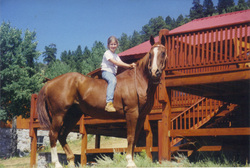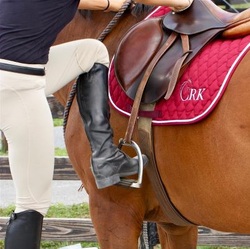Many times when riders talk about contact, it is discussed only from the perspective of the rider.
How to find steady hands or feel how much pressure to have on the reins. But the feeling of “good contact” is about more than just what the rider does with the reins, as the horse’s response is equally important.
Contact requires education, skill, and tact from both horse and rider, however it does begin with the rider.
If the rider’s rein pressure is inconsistent or jarring the horse will adapt to protect themselves, stiffening through their jaw and tensing their neck and back.
When the rider can be consistent and tactful with contact, and the horse is educated to reach into the bridle, subtle communication can happen through the rein aids, balance is improved, and the connection is positive for both horse and rider.
In this week’s video, I will demonstrate what truly creates good contact from both horse and rider and show you a simple exercise to improve your feel of the reins.
Want more simple riding tips? Check out my Free Mini-Course – Better Riding in 7 Days
Click Here to Learn More about Our Course on Using In Hand Work to Improve Your Horse’s Contact














30 Responses
my young horse fiddled with the contact constantly chomping when i bought her i gave her the winter off to mature but when i have started her off again she is doing the same thing – no problems back, teeth, saddle etc and i use a caveson noseband and not tight try to work her forward to a consistent contact but how can I help her improve – obviously when she has been brocken in this has been poorly done – it is a little bit of anxiety I know as well and hopefully over time as she goes new places this will lessen – any recommendations please?
Hi Gerry, is this with the same bit or have you a tried a variety of different bits with her?
-Julia Burdy, CRK Training Community Manager
Hi!
Quick question regarding pressure and release with reins: How do you release the reins once a horse softens without completely giving away the contact? Where’s the happy medium?
Thank you!
Hi Bee, when you are very first introducing this concept you do want to release the contact completely as the release for the pressure!
-Julia Burdy, CRK Training Community Manager
The link to the hand work video is not opening…
Hi Susan, try click here to this link!
-Julia Burdy, CRK Training Community Manager
My horse braces pretty heavily against the bit. When she first came to me, she wouldn’t walk, continually popping in to the trot. Her neck was overdeveloped on the underside (and still is but not as bad) We worked on walk for months, gradually taking up contact, and her walk is quite lovely now, until you move to a higher gait. I have worked quite a bit on my hands and soft steady contact, but the bracing perisits especially at the higher gaits. I work on suppling and lateral movements to help her relax. She wants to canter but when we add canter to our workout, the rest of the workout is bringing her back. She yawns and stretches her jaw when are done riding. My plan is to continue working through the gaits as I did with the walk but wanted to see if you had any other ideas or suggestions to add. Love your videos, so helpful! Thank you for making all this content availble!
My young mare is starting to take contact. She is on and off. I walked my fingers or squeeze the reins. But, I lose contact with her and have to try to get her to take contact, again. Is this my learning curve or hers or both?
Leslie, it is really hard for me to say without seeing! I would recommend asking someone to take a video of yourself and watch it, then come back and review this video!
-Julia Burdy, CRK Training Community Manager
Great video and explanation. Thank you. I’ve only been taught about the horse taking contact.
Hi Callie, Thank you for you video. I am starting to feel a nice contact with my horse but I find that when I am doing dressage exercises this is still very intermittent- for example we will get good contact for a few seconds and then he will lift his head up again into more of a bracing position….am I right to say that this a normal part of the journey? is it just a matter to working through this by asking consistently and allowing him to build sufficient muscle tone to take up contact for longer periods of time? Thank you
Corinne, you have diagnosed some it it yourself! It may take him a little while to develop the muscles he needs to carry himself in that better posture! I would also recommend just making sure your saddle fits to make sure that it isn’t causing him any discomfort when he is trying to find that better posture.
-Julia Burdy, CRK Training Community Manager
Great video and teaching.
Nice video on contact which is quite clear and well laid out. I was especially pleased that mention was made of the importance of the whole body being in balance I order to assist in producing flexible consistent contact. It might be useful to add in that there should be a slight flexion of the wrists with knuckles slightly turning in to aid the pliability of the hand/wrist
Dee, great recommendation – thanks for adding that tip!
-Julia Burdy, CRK Training Community Manager
Thanks once again Callie. I am currently rehabbing a wonderful horse who in the past has had some great dressage training. He is wonderfully willing and responsive BUT he was used for western gaming for the 2 or 3 years before I got him. He is terribly mouth defensive, and came with a totally upside down neck. After 8 months, the neck is much better, he is starting to trust my hand and allow soft contact without actually putting his chin on his chest, but his jaw is still somewhat stiff and he is not yet ready to seek contact himself. He has relaxed somewhat in his gaits and no longer seems as afraid he will be asked to gallop off at a moment’s notice. He is not being naughty, just ready to do what he thinks he will be asked to do. My question is, do I just keep on with what I am doing, and incorporating your excellent suggestions and exercise, or is there anything else I can do to help him? Thanks
Hi Anna! Sounds like you have come really far with him – congratulations on your progress so far!
I would recommend signing up for Patrick’s workshop there are lots of exercises in there that you can start to work from the ground and help him better understand how to seek contact before trying from the saddle.
-Julia Burdy, CRK Training Community Manager
Thank you! The link to the course on using In Hand Work to Improve Contact does not seem to be working. Very interested in working on that with my horse. Can you kindly fix? Thanks!
I found same problem. Link to In Hand class isn’t working.
Hi Debbie! Click here, and let me know if that link works!
-Julia Burdy, CRK Training Community Manager
Hi Amanda, try clicking this link: https://www.balanceinhand.com
Let me know if that works!
-Julia Burdy, CRK Training Community Manager
Callie,
Thank you very much for your videos. I really enjoy watching them!
Thank you for the informative video Callie. I am currently using the in hand work with bit and bridle on my mare Heidi. After taking Patrick’s course you offer , the education has assisted me in educating myself on the independence and feel of each rein. The in hand work has been truly beneficial with my current level of riding skills. My sensitive mare Grace has been reintroduced to a bit, and I am starting to add the bridle this week. Progress is slow and steady. Looking forward to Patrick’s next course you offer online.
Hi Callie,
I have adopted a senior Warmblood, who is quite experienced – he was an English show horse at one point in his career, then a kids’ camp horse before ending up at auction. I am riding him bitless at this point, which is new-ish to both of us. My issue is that he loves to cut corners in the arena. I would love to know the most effective way to teach him to stay out on the perimeter. Thank you.
Hi Lori! I would recommend making your that you are not leaning in on those corners, if you shift your weight to the inside he will have to stay underneath of you!
-Julia Burdy, CRK Training Community Manager
Hi Callie,
Usually I LOVE your explanations and videos. I feel as if this one was missing a really important point…..shouldn’t horses be using their hind end when accepting “contact”? The relaxation and acceptance of the bit…not resisting and not dropping behind the vertical comes from behind…otherwise it is just a head and neck position. Obviously this is for beginners and we are not expecting any collection but it seems important to add this idea to any lesson on “contact”. Love that you mention not balancing on the horses mouth!! What do you think?
Hi! You are exactly correct! The energy first has to come from the hind end of the horse and we catch that energy in the bit with our contact.
Thank you for brining up that very important point 🙂
– Julia Burdy, CRK Training Community Manager
I enjoyed your presentation.
I am wondering would like to hear you r comments on how pressure and release is applied when you are training your horse to move with vertical flexion or collection.
Dale, thanks for your question! It is the same principle Calle mentions in the video. The first step is to teach them to stretch when we take up contact, then they need to learn to hold contact for longer periods of time. From that point we can begin to lift the frame of the horse and develop more and more collection.
With all of that being said it is important to also consider the fitness of the horse – we have to make sure we are only asking them to do what they can physically do in the condition they are in.
Hope this makes sense!
Julia
My horse seems to turn her head to the wall/fence, and I don’t know what to do with the reins to correct her…she “falls in” with her shoulder , and if I use the reins to try to get her face the correct direction with her head , we wind up spiraling to the inside.
My teacher has me trying to use my weight to move her body to the rail, and then tells me that my hands are “too busy”, or “not quiet”. I’m frustrated …